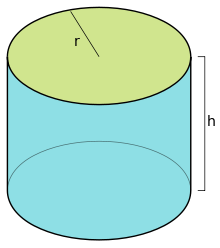A salt container is to be made in the shape of a cylinder and to contain #500cm^3# of salt. Find the dimensions for the container that requires the least amount of material. Assume the container has a top?
1 Answer
The smallest area occurs when we have a radius of
Explanation:

Let us set up the following variables:
# {(r, "Radius (cm"), (h, "Height of can (cm)"), (A, "Surface Area of can (sq cm)") :} #
We want to vary the radius
Then the volume is fixed:
# pir^2h = 500 #
# :. h = 500/(pir^2) #
And, The Surface Area is given by:
# \ \ \ \ \ A=2pirh + 2pir^2 #
# :. A=2pir(500/(pir^2)) + 2pir^2 #
# :. A=1000/r + 2pir^2 #
Differentiating wrt
# :. (dA)/(dr)=(-1000/r^2) + 4pir #
At a critical point,
# :. (-1000/r^2) + 4pir = 0 #
# :. -1000 + 4pir^3 = 0 #
# :. r^3 = 1000/(4pi) #
# :. r = root(3)(1000/(4pi)) #
# :. r = 4.30 (2dp) #
With
# A=1000/(4.30) + 2pi(4.30)^2 #
# :. A=348.73 (2dp) #
We should check that this value leads to a minimum (rather than a maximum) area. As the size of the can is finite this should really be intuitive. We could calculate the second derivative and verify that
graph{1000/x + 2pix^2 [-15, 10, 200, 490.7]}
Hopefully you can visually confirm that a minimum does indeed occur when

